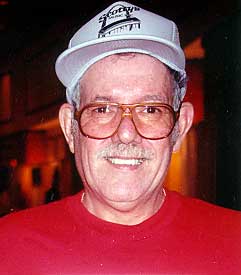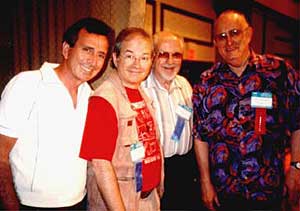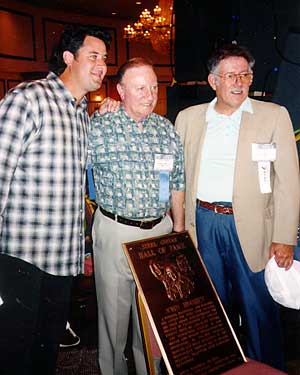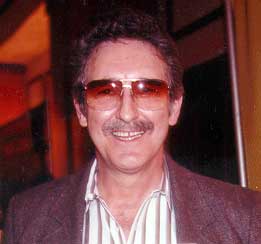
 |
|---|
In the early 1960s a music store owner and a dyed in the wool steel guitar fan from St. Louis traveled to Nashville for the yearly Disk Jockey convention. He heard some amazing playing while there, but realized that none of that playing was to be heard on the records where, he said, "I heard only what the producers wanted me to hear. The players got to play only what the producers wanted them to play." He told friends about the amazing music he had heard in some of the Nashville places, but many of the places were "dives" and most "tourists" didn't feel like wandering in.
DeWitt Scott ("Scotty" to his friends) decided that the only way he could share what he heard in Nashville was to bring it to where he was. In late 1968 he brought Maurice Anderson, a steel guitar swing and jazz whiz, to St. Louis. 65 people showed up to listen. A few months later he brought the grand steel stylist Curly Chalker to St. Louis and 100 people showed up.
Over the next three years he did three more shows, with increasing attendance at each show. In 1971 he put on the "First Annual Steel Guitar Show" which played to 400 people.
When I became interested in pedal steel, I found out about the show. I was negotiating the writing of a steel guitar instruction book with Oak Publications, and I realized that one thing I must have in the book was photos of all the players. Where could I see them all in one place? At St. Louis, of course. I grabbed my Nikon and flew out for the 1974 show. It was like going to heaven.
St. Louis is an hour behind the east coast. I left Philly at about 5 p.m. and got to the Hotel by 7 p.m. local time. I heard some music in a nearby room and walked in. I was stunned. Sitting in the room playing duets were Red Rhodes and Zane Beck. Watching them was the grand old man himself, Speedy West. And there I was, one of the six people in the room-- just two hours away from my regular life. It was an amazing time. Starting on Friday night, there was a different steel player on stage every half hour. And when the show stopped at about midnight, it continued in the rooms. 550 people were treated to the best in steel guitar playing. The top Nashville players were there and playing what THEY wanted-- not what they were asked to play.
I also met a number of the manufacturers there. Although there have been attempts at mass production, this instrument does not lend itself to such efforts. There are not many players, and the market for pedal steels is not large. Making pedal steels in certainly a low-volume business.
Most who make the instrument are themselves players who happen to be machinists or have good friends who are. At this time (1974), the market had been cornered by the Sho-Bud, Emmons, and ZB (Zane Beck) companies, but a number of other "low production" people were starting to show their wares.
With my background in industrial design, and my access to a machine shop at the school at which I was working, I had already had built my own pedal steel. The time at St. Louis was doubly rewarding-- not only was I hearing great music and meeting great players, but I was meeting a number of makers and innovators. It was grand!
I had, in my previous musical incarnations, been to large folk festivals where the audience was, essentially, kept apart from the performers. If you had a favorite performer you wanted to talk to, it was next to impossible to get through the back-stage security.
 |
|---|
The bluegrass festivals I went to were a bit better, but most of the "big acts" retired to their air-conditioned bus when they weren't playing, and there was little interaction between the performers and the audience.
That was not the case in St. Louis. Everyone was accessible to everyone else. We all ate in the same restaurant. I managed to discuss my book idea with both Jeff Newman (whose instruction records I had learned from) and Lloyd Green ("Mr. Nashville Sound") whose friendship I gained over the next few years. Want to know how Buddy Emmons did that lick on that record? Just ask him!
I came home on a cloud.
 |
|---|
I went back the next year. It was more of the same. This time it was held at a small hotel in St. Charles where the entire hotel was, essentially, booked by the convention. At about 4 a.m. on Saturday night the police showed up. They had a complaint about noise. Scotty said, "Who can complain? I have all the rooms!" Turns out one of the guests said, "I love music, but this is too much! I need sleep!" and called the authorities.
By 1976 the convention moved to the Chase Park Plaza Hotel and had 1500 people in attendance. The Chase Park Plaza was an amazing hotel. Actually, it was two hotels, the Chase and the Park Plaza. The Chase, "one of the most expensive hotels of the time," was opened in 1922. The story is told that shortly after its opening a businessman tried checking in to the Chase. He was turned away because he was Jewish. In 1929 he returned, built a grand 29 story hotel right next door to the 11 story Chase, drove it out of business, and bought it out. The two hotels were joined by a series of internal passages. The Chase was showing its age. The Park Plaza was also getting old, but the opulence of it could still be seen.
It was here, and later at the Clarion hotel, to which it moved in 1984, that the International Steel Guitar Convention really came into its own. Now at the same location (with a new name: "The Millennium & Four Points Sheraton Hotel") the Convention attracts 4,000 people every Labor Day Weekend.
 |
|---|
Since I moved to New Zealand, I haven't been to St. Louis since 1996, but I can't imagine that it has changed very much. I've often described it as akin to the "bar scene" in the first Star Wars movie-- where all species congregate in a place of "neutral ground." I'm sure some of these folks would have little in common were they to meet on the street or worse, might even see the other as "enemy" because of their dress, habits, political affiliations and/or religious convictions. But here for one weekend in St. Louis, all is calm. You can find the very clean tie-and-jacket folks who believe that the steel is an instrument of the Bible because of the Biblical reference to "an instrument of ten strings," deep in conversation about knee lever arrangements with someone who looks like a biker and is wearing a t-shirt that says, "I fuck Armadillos."
Only at St. Louis.
It is, generally, not a young crowd, and gets older every year as few younger players are drawn to the instrument. It is much like the crowd seen at the Grand ol' Opry in Nashville. As a performer said one year:
"What is the difference between Jurassic Park and the Grand ol' Opry? Well, one is like an amusement park filled with extinct species and dinosaurs, and the other is a pretty neat movie!" It did not go down well.
 |
|---|
Sometimes, you just can't tell... The last time I was there I was standing in the lobby having some dealing with the hotel staff. My wife saw a guy come in and she said to herself, "This person does not look like he belongs here"-- waist length hair in a pulled back pony-tail, tie-died sleeveless t-shirt, several earrings, and lots of tattoos-- certainly a biker and someone to avoid. Before she could even say anything to me, he headed directly across the lobby and grabbed me in a big hug. "Great to see you, Winnie," he said. It was Buddy Cage-- who I hadn't seen in years. Buddy started his career with Ian and Sylvia in Canada and is best known for his work with The New Riders of the Purple Sage-- the country rock band that was an offshoot of the Grateful Dead. That year he began playing at about 11 p.m. with a rock and roll band bordering on heavy metal. The older audience was not appreciative and the hall emptied quickly. Those who remained were treated to over an hour of magnificent steel playing.
 |
|---|
St. Louis is certainly "big hair" time. Unabashed patriotism and Christian fundamentalism shine through. Over the years several players have announced their being "born again" from the stage, and a few years ago one player played a few patriotic songs like "America the Beautiful" and urged the veterans in the audience to stand and asked the audience to pay thanks to those who have defended their country in time of need.
My wife, a born and bred New Zealander, found the patriotic and religious display amazing and a bit "over the top." Only in America.
On another level, you have the varying likes and dislikes of the audience. "Too much country," say those jazz aficionados. "Too much jazz," say the died in the wool country fans. "Not enough western swing," say others.
 |
|---|
Over the years a number of "guests" have appeared, and Scotty had made no effort to give them any publicity. "This is a treat for those who are here," he told me. "I am not in business to promote them to their fans."
One year Ray Price showed up and had Buddy Emmons (who played with him years ago) back him up. Another year Porter Wagoner came with his band and did a guest set. Once, Waylon Jennings and Jessie Coulter played an hour long set on a Sunday morning, with steel great Ralph Mooney in the band. They were on their way to an afternoon "Labor Day" show and came by to let Ralph shine.
 |
|---|
The year that John Hughey was inducted into the Steel Guitar Hall of Fame, country super star Vince Gill (who used Hughey on his records and many of his in-person shows) came to present the award, and stayed around for the afternoon, sitting on the stage playing back-up guitar for all comers.
To me, the best guest was way back at the Chase Park Plaza. I was there with my record producer, Ken Bloom, who had started off as a sax player in high school in Hollywood, and then branched into other musical idioms. He had always talked about his "idols" and one was Tex Beneke-- the sax player who had taken over the Glenn Miller Band during W.W.II when Miller was killed in a plane crash. As much as Ken loved the playing of Tex Beneke, he had never seen him live, and was content to admire him via the few recordings he made.
On the Saturday evening, the old Bob Wills Western Swing Band came on, fronted by steel player Leon McAuliffe. McAuliffe announced that "a friend" was going to be playing sax with them for the set. It was Tex Beneke. Bloom was in seventh heaven!
It turns out that McAuliffe was walking though the hotel lobby when he spotted his old friend. They used to play with each other when they were in the service during the early part of the war. Beneke was visiting his in-laws and was staying at the hotel. "Have your axe?" asked McAuliffe. "Sure do," was the reply. "Well, I'm playing tonight. Want to sit in?" And what a show it was!
The same year saw steel great Curly Chalker as the last player on Saturday night. Starting at about 11:30, Curly was well along the road of inebriation. Drinking a constant supply of "7 and 7" he held forth for well over two hours. Some of those in the audience were upset that someone that drunk was allowed to be on stage in public. Those who were less concerned about his demeanor were treated to the most amazing music I have ever heard. All internal censoring-barriers were dropped, and whatever came into his head came out of the amp. I have never seen or heard such masterful playing of the instrument.
 |
|---|
 |
|---|
There was the time that Bobby Koefer played. Koeffer was a steeler who played with Bob Wills. Both Buddy Emmons and Jimmie Day were listening to Koefer in their formative years. As Koefer played both Emmons and Day were watching from the foot of the stage, grinning from ear to ear, poking each other and laughing when Koefer did something completely outrageous, and occasionally slapping their foreheads in awe. Where else can you have the "best in the business" be so thoroughly open in their admiration of another player?
And there was the time that Joaquin Murphy was lured away from his retirement in California to play a half hour to folks, many of whom had only heard of him. He was unreal. I was standing in the back of the hall listening when Lloyd Green sidled up. "Good, huh?" he said. I replied that he certainly had "that tone." "Yes," replied Lloyd, "you had to be there at that time to get it. It was something that happened at that time-- just before the War. I learned all those tunes, and know all the notes, but could never get "that" tone. It was part of the gestalt of the pre-war times. I was a bit too late." A most interesting observation.
Along the way, there has been a few funny moments: Jeff Newman putting a paper bag over Buddy Emmons' head while he was playing (and Buddy just kept on... as good as ever!), Speedy West coming out and playing with a bar that was about a foot in diameter, and a number of other pranks and jokes. But there are two which do "take the cake."
One year Jeff Newman was bragging about how "hot" he was, and he and Bobby Caldwell (the guitar player) got into a "jam" that ended in getting faster and faster. Then Jeff set off the smoke bomb under his steel, and smoke began to rise off his hand. At which point, Scotty ran out and doused it with a fire-extinguisher. But it was the wrong type of extinguisher. It wasn't a CO2 one, but one that put out a blanket of fine powder. It got into all the speakers and into all the instruments on stage. In the end it was a real mess-- little of which the audience saw.
The next year I was visiting Joe Kline on the drive out, and he said, "Look at this." It was a beautiful Kline guitar that was made from pine and stained. It had strings, but no mechanism. The pedal rods all hooked into screw-eyes on the front apron. The fingerboard was painted on. It looked just fine-- from a distance. I had an inkling that a major event was to take place.
At the convention that year Jeff played his set. He was playing a Kline. Jeff finished, carried off his steel and went back to get his pack-a-seat. At which point he was accosted by Bobby Caldwell. Bobby told him how much damage the stunt with the fire extinguisher did the year before. It got into all the controls of his guitar, as well as into the body. It was not fun. And then Bobby says, "I'm still hotter than you. I can cut you at any time. I can even do it on your own guitar." The audience, knowing that Bobby is a closet steel player, went wild. So Jeff goes and bring his guitar out again-- the pine Kline, of course. Bobby sits at it, Jeff takes up Bobby's guitar, and the band launches into a fast number. Of course, Bobby can't keep up. He says to Jeff, "I can still cut you," and pulls out a snip and cuts all the strings off the guitar. Jeff is undisturbed. Bobby, exasperated, says, "I can still cut you" and goes off stage and returns with a bolt-cutter and proceeds to cut through all the pedal rods. Jeff is still undisturbed. Bobby says, "I can still cut you," and goes off-stage-- returning with a running chain saw-- and proceeds to cut the Kline in half. "
The funny part, to me was that half the audience laughed and the other half sat stunned... "He cut Jeff's guitar in half!" It was a great little play!
So that's St. Louis. And it all came about because of Scotty's vision. Bless the Scott family for organizing it all.
For more information about the Convention, check Scotty's web-site.